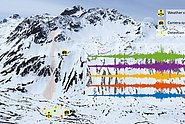The destructive power of avalanches demands fast detection and early warning systems to mitigate avalanche risk in mountain areas. Since avalanches are extended moving sources of seismic energy, array systems based on seismic sensors can be used to monitor avalanches over wide areas, regardless of weather and visibility. Operationally, one of the main challenges of these detection systems is the automatic discrimination of avalanche signals from other sources. Various machine learning techniques have, therefore, been used to automatically differentiate avalanche events within seismic recordings. So far, these models mainly relied on expert knowledge and a time-consuming selection process to extract signal attributes from the time and frequency domains. In this study, we therefore investigate the detection performance of models trained with expert-derived features and fully automatic extracted features using autoencoders. Autoencoders are neural networks that efficiently compress (encode) input data, such as seismic signals, down to its essential features to reconstruct (decode) the original input. Hence, meaningful features can be automatically learnt during this process. To develop the models, we use a catalogue of labelled events recorded by a seismic array system deployed above Davos (Switzerland) since the winter season 2020-2021. We assess the performance of different classifiers developed with data from individual sensors by aggregating the predictions from all array components through ensemble predictions. Our results show that models trained with autoencoder-extracted features performed as well as those relying on expert features and spectrogram images. When tested on a continuous seismic dataset, the autoencoder model based on the frequency content of the signals achieved the best balance between avalanche detection accuracy and false alarm rate. Looking forward, we aim to integrate the best approach into an operational, near-real-time avalanche detection system.
See Institutional Repository DORA